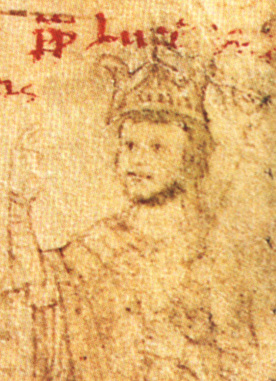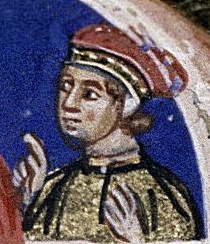
Pope Alexander III, born Roland, was head of the Catholic Church and ruler of the Papal States from 7 September 1159 until his death in 1181.
The Third Council of the Lateran met in Rome in March 1179. Pope Alexander III presided and 302 bishops attended. The Catholic Church regards it as the eleventh ecumenical council.

The 12th century is the period from 1101 to 1200 in accordance with the Julian calendar. In the history of European culture, this period is considered part of the High Middle Ages and overlaps with what is often called the "'Golden Age' of the Cistercians". The Golden Age of Islam experienced significant development, particularly in Islamic Spain.

Frederick Barbarossa, also known as Frederick I, was the Holy Roman Emperor from 1155 until his death 35 years later. He was elected King of Germany in Frankfurt on 4 March 1152 and crowned in Aachen on 9 March 1152. He was crowned King of Italy on 24 April 1155 in Pavia and emperor by Pope Adrian IV on 18 June 1155 in Rome. Two years later, the term sacrum ("holy") first appeared in a document in connection with his empire. He was later formally crowned King of Burgundy, at Arles on 30 June 1178. He was named Barbarossa by the northern Italian cities which he attempted to rule: Barbarossa means "red beard" in Italian; in German, he was known as Kaiser Rotbart, which in English means "Emperor Redbeard." The prevalence of the Italian nickname, even in later German usage, reflects the centrality of the Italian campaigns to his career.

Pope Lucius III, born Ubaldo Allucingoli, reigned from 1 September 1181 to his death in 1185. Born of an aristocratic family of Lucca, prior to being elected pope, he had a long career as a papal diplomat. His papacy was marked by conflicts with Holy Roman Emperor Frederick I, his exile from Rome and the initial preparations for the Third Crusade.
Callixtus III was an antipope from September 1168 until his resignation in August 1178. He was the third antipope elected in opposition to Pope Alexander III during the latter's struggle with the Emperor Frederick Barbarossa.

Galdino della Sala, Galdinus or Galdimus, was a Roman Catholic saint from Milan in northern Italy. He was a cardinal elevated in 1165 and he also served as Archbishop of Milan from 1166 to his death in 1176. He was a staunch supporter both of Pope Alexander III, and of Milan and its neighbours in Lombardy, in their joint and parallel struggles against the Antipope Victor IV, supported by Holy Roman Emperor Frederick I Barbarossa.

Beatrice I was Countess of Burgundy from 1148 until her death, and was also Holy Roman Empress by marriage to Frederick Barbarossa. She was crowned empress by Antipope Paschal III in Rome on 1 August 1167, and as Queen of Burgundy at Vienne in August 1178.
Christian I (c. 1130 – 23 August 1183), sometimes Christian von Buch, was a German prelate and nobleman. He was Archbishop of Mainz and Archchancellor of Germany from 1165 until his death in 1183. He was originally elected archbishop in 1160 in a disputed election. He served the Emperor Frederick I as a diplomat in Italy on two occasions.

The Kingdom of Italy, also called Imperial Italy, was one of the constituent kingdoms of the Holy Roman Empire, along with the kingdoms of Germany, Bohemia, and Burgundy. It originally comprised large parts of northern and central Italy. Its original capital was Pavia until the 11th century.

The Treaty of San Germano was signed on 23 July 1230 at San Germano, present-day Cassino, ending the War of the Keys that had begun in 1228. The parties were Pope Gregory IX and Frederick II, king of Sicily and Holy Roman emperor. On 28 August at Ceprano, the peace was finalized with the readmission of the excommunicated Frederick into the church.
Conrad of Wittelsbach was the Archbishop of Mainz and Archchancellor of Germany from 20 June 1161 to 1165 and again from 1183 to his death. He was also a cardinal of the Roman Catholic Church.

Jacopo Tiepolo, also known as Giacomo Tiepolo, was Doge of Venice from 1229 to 1249. He had previously served as the first Venetian Duke of Crete, and two terms as Podestà of Constantinople, twice as governor of Treviso, and three times as ambassador to the Holy See. His dogate was marked by major domestic reforms, including the codification of civil law and the establishment of the Venetian Senate, but also against a mounting conflict with Emperor Frederick II, which broke into open war from 1237 to 1245.

Vitale II Michiel was Doge of Venice from 1156 to 1172.
Events during the year 1177 in Italy.

Henry VI, a member of the Hohenstaufen dynasty, was King of Germany from 1169 and Holy Roman Emperor from 1191 until his death. From 1194 he was also King of Sicily.
Guala da Telgate was a bishop of the Roman Catholic diocese of Bergamo.
Joannes Anagninus was a cardinal of the Roman Catholic Church. He was a native of Anagni, and belonged to the family of the Counts of Anagni, the same family which produced Pope Innocent III. His colleagues called him, and he called himself "Joannes Anagninus". In 1191, he subscribed himself Joannes comes Anagninus, episcopus cardinalis Praenestinus. He was successively cardinal deacon of S. Maria in Portico, cardinal priest of S. Marco, and cardinal bishop of Palestrina.
From the time of Constantine I's conversion to Christianity in the 4th century, the question of the relationship between temporal and spiritual power was constant, causing a clash between the Church and the Empire. The disappearance of imperial power initially enabled the pope to assert his independence. However, from 962 onwards, the Holy Roman Emperor took control of the papal election and appointed the bishops of the Empire himself, affirming the pre-eminence of his power over that of the Church. However, such was the stranglehold of the laity on the clergy that the Church eventually reacted. The Gregorian reform began in the mid-11th century. In 1059, Pope Nicholas II assigned the election of the pope to the college of cardinals. Then, in 1075, Gregory VII affirmed in the dictatus papae, stating that he alone possessed universal power, superior to that of the rulers, and withdrew the appointment of bishops from them. This marked the start of a conflict between the Papacy and the Emperor, which historians have dubbed the "Investiture Dispute". The most famous episode was Henry IV's excommunication and his penance at Canossa to obtain papal pardon. At the end of this conflict, the Pope succeeded in freeing himself from imperial guardianship. In 1122, under the Concordat of Worms, the Emperor agreed to the free election of bishops, reserving the right to give prelates temporal investiture. This compromise marked the defeat of the Empire.











